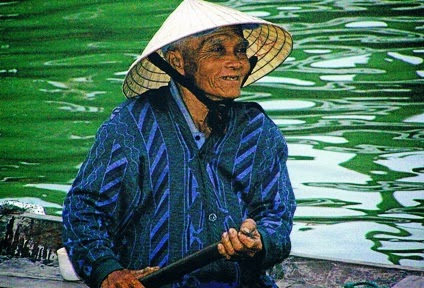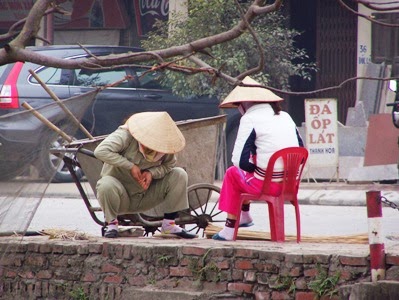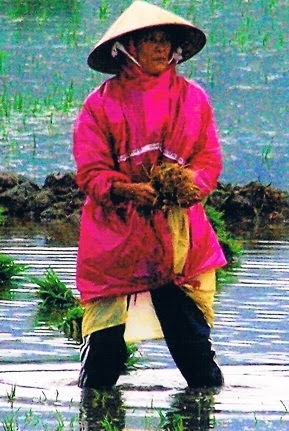“Life
is not measured by the number of breaths that you take, but by the moments that
take your breath away.”
Though the origin of this quote
is unclear, there can be no doubt that there are moments in life that
do, indeed, take one's breath away. If
we are very fortunate we get to experience several of those magical moments
during a lifetime. One of those times
for Mike and me was on a photo safari to Kenya and Tanzania.
We had had to adjust our priority
list for overseas trips. We wanted to go
to China before the new hydro-electric dam on the Yangtze River would irrevocably
change the country; thus, a safari to Africa was pushed back three-and-a-half years. But finally, in January 2008, our trip to
Africa was to become a reality.
 |
| The Acacia is a thorn tree found across the Serengeti. To us, it has come to symbolize Africa. |
But after all the arrangements
for the Africa trip had been made, the State Department cancelled all travel to
Kenya because of the violence surrounding the Kenyan Presidential elections in
December 2007. We were horrified and
saddened for the people of Kenya who were caught up in this tragedy. Selfishly, we were also disappointed not to
be able to make the trip because some opportunities come only once. So when the travel company called to let us know
that by early March they would be able to resume travel to Kenya we decided to
go. Fortunately, our shots were up-to-date
and our visas were still valid. The group we were originally going with
dwindled from 26 to 10; some dropping out because of time or work commitments;
others because of concern over safety.
Yes, there were vestiges of unrest from the last several months of
violence. In Nairobi the hotel and
grounds were beautiful, but we were requested not to leave the compound as a
safety precaution. At Lake Naivasha,
over 5,000 displaced people were living in tent cities established by the Red
Cross. The Kenyans with whom we came in
contact assured us that we were welcome and we truly felt welcome. While we were in the country we encountered
few other tourists, and no Americans, save our group of ten. The tourists we met were primarily German and
Australian. In safari lodges built to accommodate
200 or more, there were usually no more than 15 or so guests. Tourism is a vital part of the country’s
economy; therefore people were suffering not only from the aftermath of the violence
but also from the stagnant economy as few tourist dollars were being
spent. The Kenyans said the best help
would be for us to tell others we felt safe and enjoyed our trip. Both statements were very true. More accurately, we were awed by the
experience.
 |
| The pool at the Safari Park Hotel in Nairobi |
 |
| Our room at the Safari Park Hotel in Nairobi, Kenya |
While in Nairobi we visited Karen
Blixen's home (see our September 6, 2013 blog, Amazing Aviatrixes.) We also had the opportunity to visit the
Giraffe Center, established in 1979 to save the Rothschild Giraffe, when only 120
of these magnificent animals remained in western Kenya.
 |
| Rothschild Giraffe at the Giraffe Center. These animals were very tame and friendly. |
Leaving Nairobi, we headed
northward to the Central Highlands where we crossed the equator and approached
majestic Mount Kenya. In the early afternoon
we reached Samburu Lodge, some 220 miles (and rough miles, they were) north of
Nairobi. It is a semi -desert region in
the rugged northern frontier. What an amazing
experience to observe the animals in such close proximity and with our “zoo
mentality” it was also a surprise to see the various species mingling!
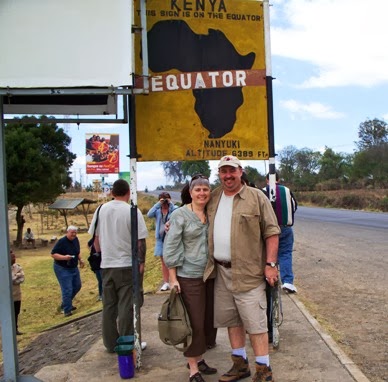 |
Crossing the Equator. Water really does swirl in opposite directions
as it drains on the north side as opposed to the south side of the Equator. |
 |
At a lunch stop, we saw this little creature, the Hyrax, a small herbivore that looks like a rodent.
12 inches tall and about 10 pounds, it is (surprisingly) related to the elephant and to the manatee. |
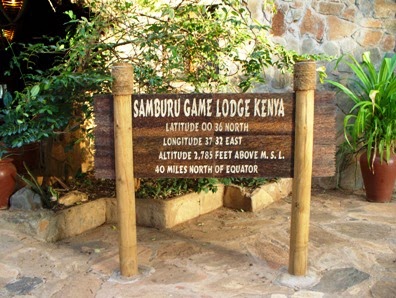 |
Samburu Game Lodge, our first overnight stop in the bush. Our group of 10 were
the only Americans at this lodge, but there were about 6 or 8 others, all Germans. |
 |
Baboons were everywhere at this lodge. They respected and stayed away from
the men but chased and were aggressive toward the women in our tour group |
 |
Herds of elephants graze in the bush. Their red-ish color is from rolling
in the dirt to cool off and to get rid of insects from their hides |
 |
African elephants can be distinguished from Indian elephants by their ears. The
ears of the African elephant are much larger and are shaped like the African continent. |
 |
Vervet Monkey. These monkeys spend most of their time in trees,
venturing to the ground only in search of food and water. |
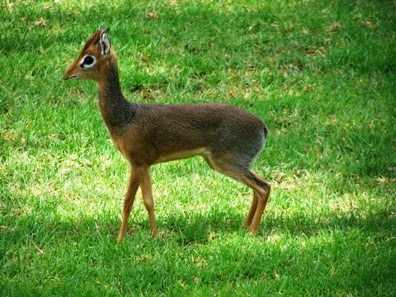 |
The Dik-Dik is a species of deer, standing 14 to 16 inches tall at the shoulder
and weighing 10 to 12 pounds. They are extremely fast. |
At first I tried to keep track of
what I was seeing on our early morning and late afternoon drives. Typically, game viewing drives were just
after daybreak and late in the afternoon when animals would be the most active. The first day my notes reflect elephants in
herds of 4 or 5, then 7 to 8, and then 30 plus, including one nursing
baby. Zebras in harems (small family
units), then in herds. Dik-Diks (a small
deer-like animal), rabbits, several towers of giraffes, gangs of Cape Buffalo,
numerous troops of baboons, ferret
monkeys, tree monkeys, herds of Impala, and Beisa Oryx (a species of
antelope). By the next day, the numbers
were so staggering I just kept listing species.
We added herds of gazelle, warthogs (with babies…oh, so cute!)
Reticulated giraffes, Grévy's zebra, Burchells zebra, gerenuks (a long necked
species of antelope), water buck, even cheetah.
And birds ...Secretary Birds, Blue-Necked Somali Ostrich, Egyptian
Vultures and on and on and on. Amazing,
SIMPLY AMAZING. It was a wellspring
of life!!!
 |
Grevy's Zebra. No two zebras in a herd have stripes exactly alike, and the stripes
on a zebra's left side do not exactly mirror the stripes on his right side |
 |
Reticulated Giraffe. While silent, giraffes seem to somehow still be able to
communicate with the rest of the "tower", the collective term for a herd of giraffes. |
 |
| Herd of elephants with the baby in tow, holding on to mom's tail with his trunk |
 |
The Gerenuk, a species of antelope. The word "gerenuk" means "giraffe neck" in Swahili. This animal
grazes on tree branches instead of on the ground, often standing on its hind legs to reach high branches.
|
 |
| The Cheetah, the fastest land animal in the world, can reach speeds of 70 mph (113 km/h) |
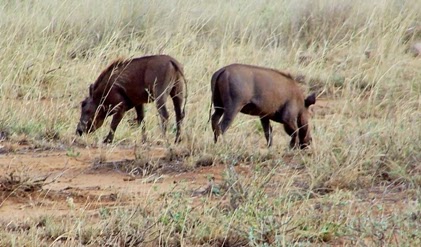 |
| Warthogs, members of the pig family, live in groups called "sounders" |
From Samburu we headed toward
Mount Kenya National Park. We stayed at
the Serena Mountain Lodge known as the “tree-hotel". This lodge is set in a forest reserve
overlooking a waterhole and salt lick.
Sitting on the third floor balcony it is possible to watch herds of
animals drinking at the waterhole. As
night falls, if you give the night steward a list of animals you would like to
see, he will wake you up if any animal on your list appears at the waterhole.
 |
Dozens of Cape Buffalo drink at the watering hole at Serena Mountain Lodge. The foliage
in the center of the watering hole has been planted in the shape of the African continent. |
 |
Often incorrectly called "Water Buffalo", the Cape Buffalo of Africa is
not related to the larger Water Buffalo which lives in India |
Animals observed here, in
addition to those previously noted, included tree lions, large spotted genet,
giant forest hog, and the elusive leopard.
Leopards are one of the most elusive animals to see. Mike and I each had an opportunity to see
one, though at different times.
Sometimes we would take different safari vans. One evening, as my vehicle rushed homeward in
the encroaching dusk (no one is allowed to be in the reserve at night, both for
their safety and to curb the possibility of poaching) we had a tire blow out. Usually if a driver/ guide had a problem he
would radio another driver for assistance, but this close to dark, that wasn't
an option. The driver pulled marginally
off the track and got out to change the tire, adamantly refusing help and
ordering us to stay in the vehicle. The
only thing he wanted us to do was watch the leopard resting in the brush,
barely 12 feet away! The safari driver
changed the tire with NASCAR speed while the leopard languorously stretched and
yawned. Apparently, the big cat had a
big dinner and wasn't much interested in our activities.
 |
The vans in which we travelled throughout Kenya. The tops are raised for observing and
taking pictures and closed while travelling on roads. Toyota makes these vans. |
As we departed Mt. Kenya National Park,
we saw the lodge where England’s Princess Elizabeth was vacationing in 1953 when her
father died, and she became the Queen of England.
Moving southward we traveled
along the magnificent Rift Valley, 100 miles northwest of Nairobi. We had an
afternoon game drive in Lake Nakuru National Park. This area is noted for vast numbers of
greater and lesser pink flamingos. Most
importantly, this is one of the premier rhinoceros sanctuaries in Kenya.
 |
| The Rift Valley, the most fertile farming land in Kenya, stretches north to south down the entire country. |
 |
| Pink flamingos by the thousands at Lake Nakaru |
 |
| A rhinoceros at Lake Nakaru co-exists with a herd of zebras |
 |
| Vultures feast on the carcass of an animal brought down by a predator |
 |
| A plains zebra, one of three species of zebras in Kenya |
Later that day we arrived at the
Lake Naivasha Simba Lodge. Here we took
a boat ride to Crescent Island, a game and bird sanctuary.
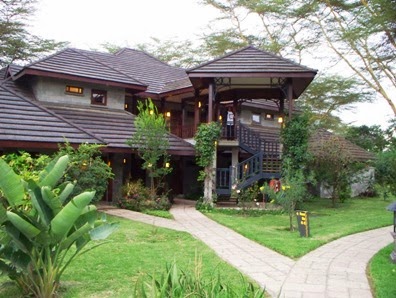 |
| Lake Naivasha Simba Lodge. During our stay, we were the only tourists at this lodge. |
 |
| Pelicans |
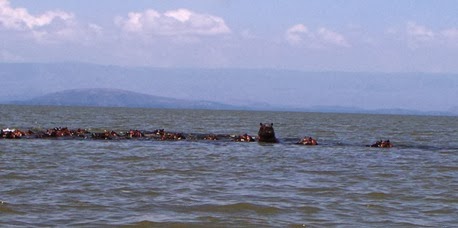 |
A "pod" of hippopotamuses. Hippos are social animals, sometimes living in groups of up to 30 animals.
Because they can get sunburned, they spend much of their lives submerged to their eyes in water. |
From Lake Naivasha, we drove
to the world-renowned Masai Mara National Reserve, considered to be the finest
wildlife area in Kenya. Here we stayed
at the Mara Simba Lodge. Sightings in
this reserve include zebra, Thomson's gazelle, Defassa water buck, Masai
giraffe, and wildebeest - - thousands of wildebeests. Along the banks of the Mara and Talek Rivers,
hippos and crocodiles fight for water rights.
Over 400 bird species have been recorded. All the “Big 5” game - elephant, lion, leopard,
rhino, and buffalo - can be found in this reserve. It is also possible to observe jackals,
hyena, bat fox, and various others species.
 |
| Crocodiles at the Mara River |
 |
Hippos in the Mara River. They are perhaps the most dangerous animals in Kenya
and the crocs don't bother them. A hippo can easily kill a crocodile. |
 |
The Spotted Hyena, Africa's most common large carnivore. In addition
to being skilled hunters, they are scavengers. |
 |
A pride of lions lounging in the grass on a warm afternoon. Note how close the
sightseeing vehicle in the background is. |
 |
| This big lion walked up to our van and lay down in the shade of our vehicle, literally feet from us. |
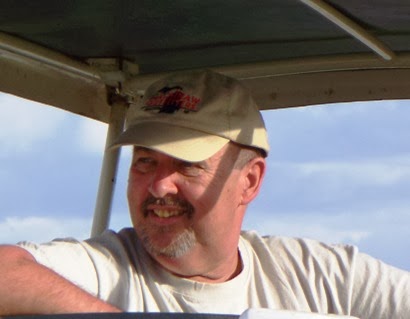 |
| Yvonne calls this her "Hemmingway" picture of Mike |
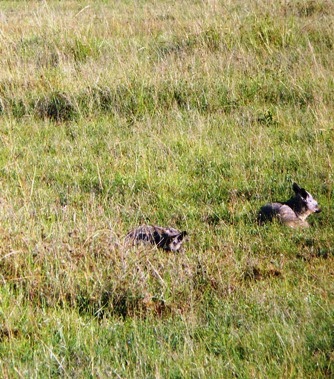 |
The Bat-Eared Fox weighs 7 to 12 pounds and is 18 to 26 inches long.
Termites make up 80% of its diet |
 |
The Topi is among the most socially advanced of the antelope family, living in herds
of 15 to 20 animals. Its black and purplish-brown markings are very distinctive |
One way to observe this area is
by hot air balloon. Mike had an
opportunity to do just that, taking off in the pre-dawn on a flight over the
vast plains of the Serengeti to see many herds of animals. During the annual Great Migration, wildebeests
and zebras trek 1,800 miles across the Serengeti, crossing crocodile-infested
rivers, sometimes a million animals moving at the same time, to reach water and
greener pasture.
 |
One of two balloons on our morning flight. Note the chase vehicles in the background. They served
a gourmet breakfast when we landed. Our pilot was an American who has flown in Africa for years. |
In a future installment, we’ll
explore Tanzania, the other country we visited on our safari.
The balloons touch down just
short of the Tanzania/Kenya border, to a waiting five-course gourmet champagne
breakfast. Aah, such is the stuff
of Road Stories.
 |
Rob and Jackie, friends and co-workers, both nurses from Boston, who we met on this
trip and who were great travel companions. Rob loved life and loved to travel. Sadly,
Rob passed away in December 2013, much too young. This blog is dedicated to him. |











